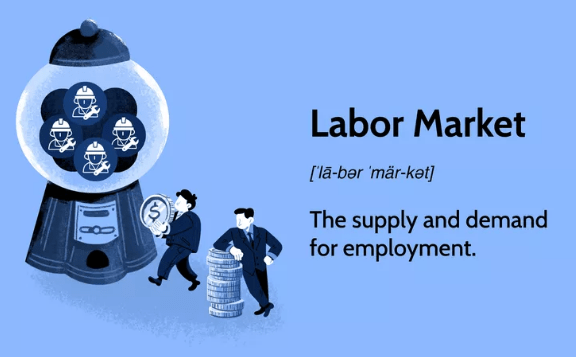Health insurance plays a critical role in shaping the labor market in the United States and many other countries. It influences job choices, employer-employee relationships, labor market mobility, and overall economic productivity. For many individuals, access to health insurance is a primary factor in their employment decisions. For employers, providing health insurance is a key strategy for attracting and retaining talent. This article explores the complex interplay between health insurance and the labor market, examining the historical context, the current landscape, and the implications for workers, employers, and policymakers.
The Historical Context of Health Insurance in the Labor Market
The Rise of Employer-Sponsored Insurance
The link between health insurance and employment in the United States began during World War II. With wage controls in place, employers sought alternative ways to attract workers, leading to the introduction of employer-sponsored health insurance as a fringe benefit. The federal government encouraged this development by making employer contributions to health insurance tax-deductible, further incentivizing employers to offer health insurance coverage.
By the mid-20th century, employer-sponsored health insurance had become the primary means of obtaining health coverage for many Americans. This model created a strong bond between employment and health insurance, influencing job stability and workers’ attachment to their employers. The reliance on employer-sponsored insurance (ESI) also had implications for labor mobility, as employees often hesitated to change jobs for fear of losing their health benefits—a phenomenon known as “job lock.”

The Emergence of Public Health Insurance Programs
In addition to employer-sponsored insurance, public health insurance programs have played a significant role in shaping the labor market. The introduction of Medicare and Medicaid in the 1960s provided health coverage for the elderly and low-income individuals, respectively. These programs expanded access to healthcare for vulnerable populations but also created complexities in the labor market, particularly concerning eligibility and coverage transitions between public and private insurance.
Health Insurance and Labor Market Dynamics
Health Insurance as a Labor Market Benefit
Health insurance is one of the most important non-wage benefits offered by employers. It serves several key functions in the labor market:
- Attraction and Retention of Employees: Health insurance is a valuable benefit that helps employers attract and retain skilled workers. A comprehensive health insurance package can differentiate an employer in a competitive labor market, making it an essential tool for talent acquisition and retention.
- Employee Productivity and Well-Being: Access to health insurance contributes to employee well-being by providing coverage for preventive care, medical treatments, and prescription drugs. Healthier employees are more productive, have fewer absences, and are less likely to suffer from chronic illnesses. Providing health insurance can therefore lead to improved workforce productivity and reduced healthcare costs for employers.
- Job Satisfaction and Employee Loyalty: Health insurance is a significant factor in job satisfaction. Employees who have access to employer-sponsored health insurance are more likely to feel valued and committed to their employer. This sense of security can foster loyalty and reduce turnover rates, benefiting both employees and employers.
Job Lock and Labor Mobility
While employer-sponsored health insurance offers many benefits, it can also create challenges related to labor mobility. Job lock occurs when employees stay in jobs they would otherwise leave because they do not want to lose their health insurance coverage. This phenomenon has several implications for the labor market:
- Reduced Labor Market Flexibility: Job lock limits labor market flexibility by discouraging workers from pursuing new opportunities, starting their own businesses, or retiring early. This can lead to a misallocation of labor, where workers remain in less productive or less satisfying jobs due to concerns about health insurance.
- Impact on Entrepreneurship: The fear of losing health insurance can deter individuals from starting their own businesses. Entrepreneurship often requires a willingness to take risks, but the lack of affordable health insurance options can be a significant barrier. Addressing job lock is essential for fostering innovation and supporting small business growth.
- Implications for Career Development: Job lock can impede career development by preventing workers from pursuing opportunities that align with their skills and interests. Workers who feel tied to their jobs due to health insurance concerns may miss out on promotions, skill development, and job satisfaction.
The Affordable Care Act and Labor Market Impacts
The Affordable Care Act (ACA), enacted in 2010, aimed to expand access to health insurance and reduce the number of uninsured Americans. The ACA introduced several provisions with implications for the labor market:
- Health Insurance Marketplaces: The ACA established health insurance marketplaces where individuals and small businesses can compare and purchase health insurance plans. These marketplaces offer subsidies to make coverage more affordable for low- and moderate-income individuals. By providing an alternative to employer-sponsored insurance, the marketplaces aimed to reduce job lock and increase labor market mobility.
- Medicaid Expansion: The ACA expanded Medicaid eligibility to cover more low-income individuals. This expansion provided health coverage to millions of Americans who were previously uninsured, reducing their reliance on employer-sponsored insurance and increasing their ability to make employment decisions without fear of losing health coverage.
- Employer Mandate: The ACA included an employer mandate requiring large employers to offer health insurance to full-time employees or pay a penalty. This provision aimed to ensure that employers continued to provide health coverage and discouraged them from dropping coverage or shifting employees to part-time status to avoid offering benefits.
Impact on Employment and Hours Worked
The ACA’s impact on employment and hours worked has been a topic of debate. Some critics argued that the employer mandate would lead to reduced hiring, increased part-time work, or job losses. However, research on the ACA’s impact has shown mixed results:
- Labor Force Participation: Studies have found little evidence that the ACA significantly affected overall labor force participation or employment rates. While some employers may have adjusted their hiring practices in response to the employer mandate, the overall impact on employment levels has been limited.
- Part-Time Employment: The ACA’s employer mandate created concerns that employers would reduce workers’ hours to avoid offering health insurance. While there was some evidence of increased part-time employment among certain industries, such as retail and hospitality, the effect was not widespread across the economy.
- Job Lock Reduction: The ACA’s provisions, such as the health insurance marketplaces and Medicaid expansion, aimed to reduce job lock by providing alternative sources of coverage. Research has shown that the ACA has had a positive impact on reducing job lock, allowing more workers to change jobs, start businesses, or retire without fear of losing health insurance.

The Gig Economy and Health Insurance
The rise of the gig economy, characterized by short-term contracts, freelance work, and independent contracting, has introduced new challenges and opportunities related to health insurance in the labor market:
- Lack of Employer-Sponsored Insurance: Gig workers typically do not have access to employer-sponsored health insurance, leading to a lack of coverage or reliance on individual market plans. The absence of employer-sponsored insurance can create financial insecurity for gig workers and limit their access to healthcare.
- Health Insurance Marketplaces: The ACA’s health insurance marketplaces have provided gig workers with an option to purchase health insurance independently. The availability of subsidies has made coverage more affordable for some gig workers, although challenges remain, such as high premiums and out-of-pocket costs.
- Policy Implications: The growth of the gig economy has raised questions about how to provide health insurance coverage for workers in non-traditional employment arrangements. Policymakers may need to consider innovative approaches, such as portable benefits, to ensure that gig workers have access to health insurance and other benefits regardless of their employment status.
Employer Strategies for Health Insurance and Workforce Management
Employers play a critical role in shaping the relationship between health insurance and the labor market. To navigate the complexities of providing health insurance, employers have adopted various strategies:
- Offering Competitive Benefits: To attract and retain talent, employers offer competitive health insurance packages that may include wellness programs, preventive care, and comprehensive coverage options. Employers often tailor their benefits to meet the needs of their workforce, taking into account factors such as employee demographics, industry trends, and healthcare costs.
- Cost-Sharing and Health Savings Accounts: To manage rising healthcare costs, many employers have implemented cost-sharing arrangements, such as higher deductibles, co-pays, and premiums. Some employers offer Health Savings Accounts (HSAs) or Flexible Spending Accounts (FSAs) to help employees save for medical expenses tax-free. These strategies aim to encourage employees to be more cost-conscious while still providing access to necessary care.
- Wellness Programs and Preventive Care: Employers are increasingly investing in wellness programs and preventive care initiatives to promote employee health and reduce healthcare costs. These programs may include health screenings, fitness incentives, smoking cessation programs, and mental health support. By focusing on preventive care, employers aim to reduce the incidence of chronic diseases and improve employee well-being.
- Telehealth and Digital Health Solutions: The adoption of telehealth and digital health solutions has accelerated in response to the COVID-19 pandemic. Employers are incorporating telehealth services into their health insurance plans to provide employees with convenient access to healthcare. Telehealth can improve access to care, reduce healthcare costs, and enhance employee satisfaction.
Policy Implications and Future Directions
The relationship between health insurance and the labor market continues to evolve, with significant implications for workers, employers, and policymakers. Several key policy considerations and future directions include:
- Expanding Access to Affordable Coverage: Ensuring access to affordable health insurance is essential for reducing job lock, supporting labor market mobility, and promoting economic stability. Policymakers may consider expanding subsidies, improving the affordability of marketplace plans, and exploring public option proposals to provide more coverage options.
- Supporting Gig Workers and Non-Traditional Employment: As the gig economy grows, policymakers need to address the lack of health insurance coverage for gig workers. Innovative solutions, such as portable benefits, universal coverage models, and gig worker-specific health plans, can help ensure that all workers have access to health insurance regardless of their employment status.
- Encouraging Employer Innovation: Employers play a crucial role in shaping health insurance and workforce management. Policymakers can encourage employer innovation by providing incentives for offering comprehensive health benefits, supporting wellness programs, and promoting telehealth adoption. Collaboration between the public and private sectors can drive innovative solutions to improve health insurance access and quality.
- Addressing Health Disparities: Health disparities related to race, ethnicity, income, and geography persist in the healthcare system. Policymakers should focus on addressing these disparities by expanding access to health insurance, improving healthcare delivery, and promoting health equity. Efforts to reduce disparities can lead to better health outcomes, increased workforce participation, and a more equitable labor market.
Conclusion
The relationship between health insurance and the labor market is multifaceted and dynamic, with significant implications for workers, employers, and the broader economy. Health insurance influences employment decisions, job satisfaction, labor mobility, and productivity. While employer-sponsored insurance remains a cornerstone of the U.S. healthcare system, changes in the labor market, such as the rise of the gig economy and evolving employment patterns, necessitate new approaches to providing health coverage.
Policymakers, employers, and stakeholders must work together to ensure that health insurance policies and practices support a flexible, innovative, and inclusive labor market. By expanding access to affordable coverage, supporting non-traditional workers, and addressing health disparities, we can create a healthier workforce and a more resilient economy. The ongoing evolution of health insurance and the labor market will continue to shape the future of work and health in the 21st century.




